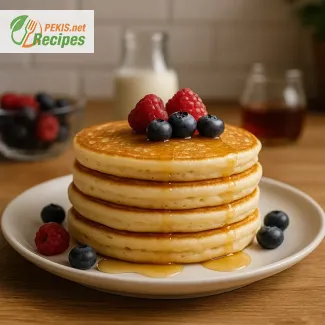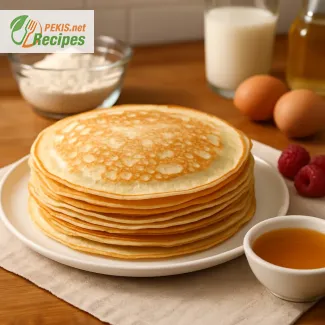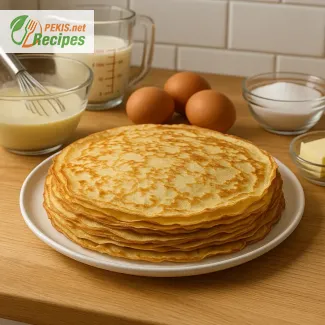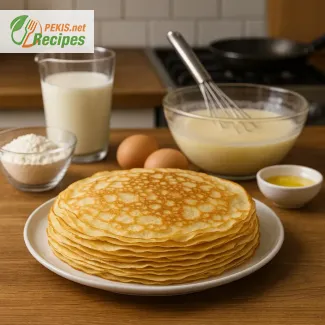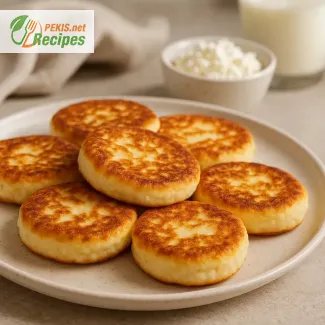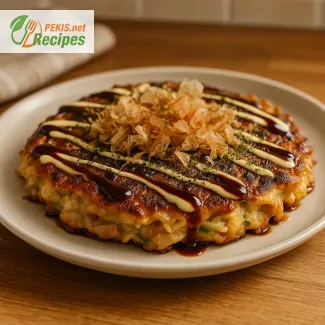
Discover the authentic flavor of Osaka’s street food legend
A traditional Japanese pancake that captures both comfort and creativity
Few dishes embody the soul of Japanese comfort food quite like okonomiyaki. Often referred to as the Japanese savory pancake, this dish is a vibrant and satisfying blend of textures and umami flavors, deeply rooted in the food culture of Osaka, yet beloved throughout Japan and beyond. With a name that loosely translates to “grill what you like,” okonomiyaki offers a level of personalization that’s rare in traditional cuisine. At its heart, it’s a mixture of cabbage, flour, and egg, cooked on a hot griddle and layered with bold toppings like okonomiyaki sauce, Kewpie mayo, bonito flakes, and nori seaweed.
The popularity of okonomiyaki has grown far beyond Japan’s borders, and it’s easy to see why. This dish is a perfect balance of savory, creamy, and crispy, appealing to anyone seeking a hearty yet playful culinary experience. Whether enjoyed in a bustling Osaka izakaya or prepared at home on a flat-top griddle, okonomiyaki delivers a unique combination of satisfaction and excitement with every bite. It brings people together at the table, inviting customization and fun, making it more than just a meal—it’s an experience.
Unlike other types of pancakes or fritters, okonomiyaki’s identity lies in its layered ingredients and its distinctive finish. The soft, moist center contrasts beautifully with the seared, golden edges. Freshly shredded green cabbage provides texture, while the base batter binds it all together. While traditional versions include thinly sliced pork belly or shrimp, the beauty of this dish is in its flexibility. Tofu, cheese, mushrooms, or even kimchi can be added without compromising the essence of okonomiyaki.
Another key element that sets okonomiyaki apart is its signature sauces and garnishes. The dark, tangy okonomiyaki sauce—often compared to Worcestershire sauce but sweeter and thicker—adds depth and umami. Japanese mayonnaise, rich and slightly tart, is artfully drizzled in thin stripes, creating a striking visual and enhancing the flavor profile. Bonito flakes, or katsuobushi, dance on the surface from the heat, adding a theatrical flourish that delights adults and children alike. Sprinklings of dried seaweed (aonori) bring a marine note that ties the entire dish back to its Japanese roots.
While okonomiyaki may seem intricate, it’s an approachable dish that rewards both beginners and seasoned cooks. Its preparation is straightforward, but it invites creativity and experimentation. Making it at home becomes a personal journey through Japanese street food culture, and recreating it allows you to adapt the flavors to your own taste while maintaining authenticity.
Whether you're planning a themed dinner night, looking for something new and exciting, or simply craving a satisfying meal that hits every savory note, okonomiyaki is a standout choice. With its combination of simplicity and richness, cultural depth and modern versatility, this dish is destined to become a favorite in any home kitchen. From the first bite of its crispy outer layer to the soft, flavorful center, every element of okonomiyaki is crafted to bring joy.
- In a large bowl, mix all-purpose flour, dashi powder, salt, sugar, and water until a smooth batter forms.
- Add the eggs and whisk gently to combine.
- Fold in the shredded cabbage and spring onions. Mix until evenly coated.
- Heat a non-stick skillet or griddle over medium heat and add a bit of vegetable oil.
- Spoon a quarter of the mixture into the pan and shape into a round pancake about 2 cm (¾ inch) thick.
- Lay a few slices of pork belly on top of the uncooked side.
- Cook for about 5 minutes until the bottom is golden brown and firm. Flip carefully.
- Cover with a lid and cook for another 5 minutes, until the pork is cooked and the pancake is cooked through.
- Flip once more to crisp both sides slightly. Remove from heat.
- Repeat the process with the remaining batter.
- Drizzle okonomiyaki sauce and Japanese mayonnaise in zig-zag or spiral patterns over each pancake.
- Sprinkle with bonito flakes and aonori generously before serving hot.
Enhancing Your Homemade Okonomiyaki Beyond Tradition
Expert tips, flavor upgrades, and healthy twists on Japan’s iconic savory pancake
Creating the perfect okonomiyaki at home goes far beyond following a traditional recipe—it’s about understanding the balance of ingredients, the potential for personalization, and the little adjustments that can elevate a good pancake into something truly unforgettable. While the classic Osaka-style okonomiyaki offers a satisfying combination of cabbage, egg, pork, and savory sauce, many cooks find joy in experimenting with textures, flavors, and nutritional content. Below, we explore ways to improve this beloved Japanese dish by focusing on ingredient choices, cooking technique, and smart substitutions.
Choosing better ingredients for maximum flavor
One of the easiest ways to enhance your okonomiyaki is to start with higher-quality ingredients. While standard all-purpose flour is the most common base, swapping it for cake flour or adding a bit of rice flour can yield a lighter, crispier texture. These flours absorb less moisture, allowing the pancake to cook more evenly and deliver that desired golden crust.
When it comes to cabbage, opt for fresh, tightly packed green cabbage and shred it as finely as possible. The more delicate the shreds, the more tender and cohesive your final pancake will be. For an extra depth of flavor, consider lightly salting the cabbage and letting it rest for 10 minutes before mixing it into the batter. This draws out excess moisture and softens the texture, leading to a more integrated bite.
Adding umami-rich ingredients such as shiitake mushrooms, fermented kimchi, or a small amount of miso paste can intensify the savory profile of your batter. These ingredients not only deepen the flavor but also enhance the nutritional value of the dish.
Creative protein and vegetable combinations
While thinly sliced pork belly is the traditional topping of choice, don’t hesitate to explore alternatives. Shrimp, scallops, or even ground chicken offer interesting textures and flavors. For a vegetarian or vegan version, consider adding pan-fried tofu, tempeh, or jackfruit for their meat-like consistency and ability to absorb flavors.
You can also mix in finely chopped carrots, zucchini, or sweet corn for color, texture, and a hint of sweetness. These additions brighten the dish and increase its nutritional profile without overpowering the core okonomiyaki identity.
Why homemade okonomiyaki is better than restaurant versions
Making okonomiyaki at home gives you full control over the ingredients, oil quantity, and cooking temperature, which directly affects taste and texture. Many restaurant versions rely on commercial sauces or excess oil to boost flavor, but at home, you can use reduced-sodium sauces, less oil, and fresher produce. This not only leads to a cleaner taste but also aligns better with dietary needs.
Homemade also allows for customization—you can adjust the thickness, toppings, spice levels, and sweetness of the sauce based on your preferences. This personalized approach makes the eating experience more enjoyable and often more wholesome.
Common mistakes to avoid when preparing okonomiyaki
Even experienced home cooks can run into pitfalls when making okonomiyaki. One of the most frequent mistakes is overmixing the batter. Stirring too aggressively or too long can develop the gluten in the flour, resulting in a tough and chewy pancake. Mix just until the ingredients are combined.
Another common issue is using too much liquid. While the batter should be moist, it should not be runny. Excess water from cabbage or over-measuring liquids can prevent the pancake from setting properly and cause it to fall apart during flipping.
The cooking temperature is also crucial. Too high, and the pancake will burn on the outside while remaining raw inside. Too low, and it will absorb oil and turn soggy. Use medium heat and cover the skillet briefly to help the center cook through while maintaining a crisp exterior.
Healthier alternatives and dietary adaptations
For those seeking a lighter version, consider replacing pork belly with lean turkey bacon, grilled chicken strips, or omitting meat altogether. Substituting the traditional mayonnaise with Greek yogurt mixed with lemon juice can maintain the creamy topping effect with fewer calories and more protein.
Replacing the standard okonomiyaki sauce with a homemade version using reduced-sugar ketchup, Worcestershire sauce, and a splash of rice vinegar allows you to control sodium and sugar levels.
For a gluten-free okonomiyaki, use a certified gluten-free flour blend and ensure that your sauces are also gluten-free. There are also egg-free options available using flaxseed meal or chia seeds soaked in water, which can mimic the binding properties of eggs for vegan preparations.
Smart cooking methods for better results
If you're making several pancakes for a group, consider using a flat-top griddle or cast iron skillet for even cooking and better heat retention. You can also keep finished pancakes warm in a low oven (90°C / 200°F) while preparing additional batches.
When flipping the pancake, use two spatulas to ensure stability and avoid tearing. Don’t rush this step—wait until the bottom is fully set before turning it over. If you like a slightly caramelized finish, let the pancake sit an extra minute uncovered on each side before serving.
To make your okonomiyaki uniquely yours, consider experimenting with toppings beyond the traditional. A sprinkle of shichimi togarashi adds spice, while a drizzle of yuzu kosho or ponzu sauce introduces citrusy brightness. Try garnishing with chopped herbs, toasted sesame seeds, or even a touch of wasabi mayo for a fusion twist.
Each of these tweaks—whether subtle or bold—can transform the humble okonomiyaki into a dish that reflects your taste and culinary creativity. As with any traditional recipe, understanding the foundation gives you the freedom to innovate without losing authenticity.
- Gluten (flour)
- Eggs
- Fish (bonito flakes, dashi)
- Soy (in mayonnaise and sauce, depending on brand)
Substitution tips to avoid allergens and gluten:
- Replace all-purpose flour with gluten-free flour mix (same quantity).
- Use egg replacer or chia seeds mixed with water for an egg-free version.
- Replace bonito flakes with smoked mushrooms for a fish-free alternative.
- Choose vegan mayonnaise and a gluten-free, soy-free okonomiyaki sauce.
- Vitamin A: 260 µg – supports immune function and vision
- Vitamin C: 48 mg – essential for collagen production and antioxidant protection
- Vitamin K: 110 µg – crucial for blood clotting and bone health
- Calcium: 90 mg – supports bone strength and muscle function
- Iron: 2 mg – vital for oxygen transport in blood
- Potassium: 450 mg – important for heart and muscle health
- Magnesium: 40 mg – supports nervous system and energy production
- Polyphenols: ~100 mg – from cabbage and seaweed, help reduce inflammation
- Glucosinolates: ~75 mg – from cabbage, linked to cancer prevention
- Selenium: ~10 µg – supports immune defense and thyroid function
